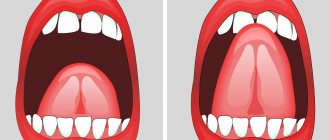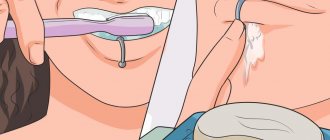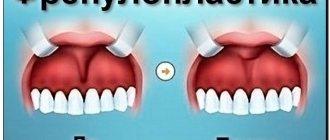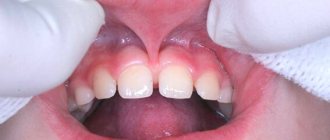Impact of frenulum pathology
Problems with speaking
But sometimes a child has a congenital pathology - shortened frenulum .
Such a diagnosis means that the frenulum is not attached in the middle of the tongue, but much closer, at the tip. Sometimes it lasts until the very tip, and the tongue even slightly bifurcates from its pressure. A serious pathology is diagnosed after the birth of a child by a neonatologist, and minor deviations in the length of the frenulum can be detected in preschool age, when the child begins to have problems pronouncing certain sounds.
Problems with breastfeeding
In infancy, a shortened frenulum can interfere with breastfeeding, as the baby cannot grasp the nipple comfortably, often loses it, and may even experience pain when sucking. This negatively affects the child’s weight gain and causes a lot of unpleasant moments for the whole family.
Functions of the frenulum of the upper lip
There are 3 frenulums in the human mouth, one is located under the tongue, 2 connect the upper and lower lips with the oral cavity. These are small mucous formations that affect the anatomy of the smile, bite, pronunciation of sounds, and they help babies latch onto the breast. If a newborn has a short or thick frenulum of the upper lip, he cannot latch onto the nipple correctly and as a result will refuse breastfeeding in favor of bottle feeding. In this case, it is trimmed in the maternity hospital, eliminating the problem.
The bridge between the lips and palate influences the formation of the child’s bite. Due to its deformation or irregular structure, defects in the dentition occur: protrusion of the front incisors forward. Such a nuisance is likely in rare cases, if the baby has permanent teeth rather than baby teeth. The problem is severe and requires long-term, expensive orthodontic treatment.
Tongue frenulum surgery
At what age should a tongue tie be operated on?
In infancy, the frenulum looks like a thin membrane and has no blood vessels or nerve endings. Plastic surgery is performed with one movement of a scalpel without anesthesia and subsequent treatment. After this simple procedure, the mother just needs to give the baby the breast; mother's milk will prevent any hygienic problems in the incision area. But this procedure may negatively affect future tongue movements due to the resulting scar. Therefore, if it is possible to avoid such a procedure, it is better to postpone the resolution of the issue to a later date.
For the mother, the main thing in this situation is to establish the process of breastfeeding.
With age, the membrane becomes stronger, blood vessels appear in it, and it is no longer possible to correct this as simply as in infancy. Usually, at a later age, a shortened frenulum is discovered during an appointment with a speech therapist, pediatrician or dentist. Signs of this phenomenon may include problems with speech, since the baby cannot make sounds that require touching the tip of the tongue to the palate or teeth. He begins to burr or lisp. Parents may also notice that the child has problems sticking his tongue out of the mouth.
Doctors recommend waiting until surgery
If a slightly shortened frenulum is detected, even at an early age, doctors recommend waiting until surgery. It can lengthen on its own as it grows.
Plastic surgery – frenuloplasty
But if this did not happen before primary school, a full-fledged plastic surgery called frenuloplasty is required. It is done under general or local anesthesia, depending on the perseverance and age of the child. The operation itself is extremely simple and does not take long, so if possible it is better to limit yourself to local anesthesia. The frenulum is cut at the tongue and moved a little further, and then sutured to functional size.
Postoperative period
The postoperative period at this age, unfortunately, requires special oral care, sometimes even taking antibiotics. The stitches are removed within a week. Once the incision and suture sites have completely healed, a long period of exercise with a speech therapist is required to ensure that the child develops proper language skills.
If a child is diagnosed with a shortened frenulum of the tongue, do not rush into action.
Early excision, although seemingly simpler, may cause speech problems later. Therefore, first, find a good pediatrician and consult to choose the optimal age of the small patient. And remember, such a problem can be solved in any case, it is only important to choose the method you need.
If you have any doubts about your child’s tongue frenulum, come to the A.Dent children’s clinic, here you will receive a comprehensive consultation and, if necessary, a course of treatment will be prescribed.
short frenulum of the tongue in a child Komarovsky
I am writing this article to help those mothers whose children have given up breastfeeding. But to a greater extent - so that such problems do not arise for everyone else. The child is hungry. He's looking for breasts. But as soon as the mother offers it, the baby turns away, arches, pushes away, and all this is accompanied by hysterical cries of the baby and mother... I myself have experienced this and I know how the child’s refusal and attempts to return to breastfeeding are difficult for the mother.
Is breastfeeding necessary for an older child?
No one argues that mother's milk is the best food for a baby. They only argue about how much a baby should breastfeed in order to grow up physically and mentally healthy. Previously, in Soviet times, they tried to transfer the baby to artificial feeding as early as possible, because a Soviet woman should work and not run home to feed the child. So we now read in books from grandmother’s bookcases: “At 6 months, breastfeeding continues only optionally, depending on the instructions of the pediatrician...” Nowadays, breastfeeding up to a year is considered the norm, although at this age weaning rarely takes place without children’s tantrums and boob demands. Isn't it because it's early? After all, the mother’s breast is not only food (a one-year-old child is quite full of “adult food”), but also mother’s love, and also protection from diseases and fears, stress and pain... So a 12-14-24-30 month old baby clings to mother’s breast, as the basis of the world, for something unshakable, reliable. That’s why it’s funny for me to hear mothers sometimes say: “But mine gave up breastfeeding at 5 months - he no longer needed it...” How is this possible?! Let's put psychology aside. Let's return to physiology. Man is an animal (don’t gasp or sigh: he’s smart, cunning, but an animal is not a plant :-)). Animals live in nature. They don’t receive maternity pay, they don’t go to the store to buy jars of puree, they don’t wean their babies until they can take food THEMSELVES and eat it. How can a 5 month old baby do this? But a one-and-a-half-year-old baby is quite capable of climbing onto the table and eating all the potatoes from his father’s soup while he runs off to the TV.
Such different children
Okay, let’s assume that I’ve persuaded you, and you’ve firmly decided to feed your baby for up to a year, or even 2-3. Let's move on to the most important thing - the reasons for a child's refusal to breastfeed and ways to overcome difficulties. I conditionally divided them into two groups: physical and psychological. Why conditional? Yes, because sometimes it is difficult to determine which group of problems a given one belongs to. Moreover, as a rule, refusal occurs for several reasons at once. But first I would like to write a little about the characteristics of children. Our children, like all adults, have different temperaments from birth. Some of them cannot be harmed by anything, they look at the world philosophically, confidently suck on their mother’s breast, and after that they sleep soundly. And others... screaming, crying - someone looked wrong, yelling - mom speaks louder than usual, shuddered - something fell. Some, if something doesn’t work out, continue to try again and again, while others, as soon as things don’t work out, give up everything and sit down to cry. Calm and nervous, persistent and lazy suckers, sleepyheads and vigorous ones, strong and weakened. Such different babies... It is clear that breastfeeding will develop differently for such babies. So, after reading about “what could happen”, do not be alarmed - it is not necessary that any of the above will lead to a refusal of breastfeeding. It is also worth knowing that failure can be short-term and persistent. Short-term: “Mom smells unusual. I won’t suck.” And as soon as mom takes a swim, everything gets better. But if this is repeated constantly, the failure may become persistent and then, in order to return a full-fledged breastfeeding, much more effort will need to be made.
What to do if the baby wants to eat, but does not want to breastfeed?
HERE ARE THE BASIC ACTIONS: 1) calm down - the bond between mother and baby is very strong. If the mother is nervous, the baby becomes even more nervous. 2) try to determine the cause of the failure and, if possible, eliminate it. 3) take a break from everyday worries. Let the apartment remain uncleaned for a couple of days, and let the husband eat dumplings. 4) Go to bed with your baby. It is very desirable that there is skin-to-skin contact - undress. Calm the baby, talk to him in a calm voice, sing lullabies, offer your breast. Sometimes awake babies do not want to take the breast, but sleeping or half-asleep babies suckle well. Use it. Stay in bed for a few days until things get better. Try not to be separated from your baby even for a minute. Explain to your relatives how important this is, let them help you - bring food and drink to bed, do not make noise or distract you. The main thing in returning the baby to the breast is your confidence that this is necessary for you and the baby. And don’t immediately run for formula and a bottle - this will kill the very possibility of further breastfeeding. Don’t be afraid that the child has eaten almost nothing for a day - a baby with a normal weight can easily withstand 1-2 days without food. Moreover, even if the child refuses, he still sucks a little. And there - hunger is not an auntie, he will have to take the breast. This is what my mother proved by keeping me, 3 months old, on a starvation diet for 3 days. And then I suckled on my breast like a sweet little thing for up to a year. So, the main thing is endurance. This is what should be done in case of any serious breast refusal, and then additional actions that vary depending on the reasons that led to the refusal. And now the actual reasons and their solutions.
PHYSICAL REASONS
1. INCORRECT ATTACHMENT TO THE BREAST. Cause:
The child does not grasp the areola, but sucks only the nipple - the milk does not flow and the child is upset.
Treatment:
1) hold the child in your arms until he calms down 2) lubricate the nipple and areola with milk, lightly squeeze the areola with your fingers to make it easier for the child to grab it, offer it to the baby.
3) make sure that the child does not “slide” towards the nipple. Reason:
When feeding, you hold your breast and hold the baby close to you.
But when there is pressure on the breasts, the milk ducts are blocked. And the child is simply not comfortable lying like that. Treatment:
Position your baby correctly. Do not press too hard; the head should not turn to the side during feeding.
2. Cause
: THE CHILD CANNOT LATCH ON THE FULL BREAST
Treatment
: before feeding, express a little milk so that the areola becomes soft.
3. RETRACTED, FLAT, SMALL NIPPLE Treatment:
1) for many women, such nipples do not interfere with feeding their children. Think about it: if in nature the children of women with such breasts died of starvation, then, according to genetics, no one would have had such breasts for many millions of years. Over time, with regular feeding, the nipple takes on a normal appearance. 2) if that doesn’t work, feed with feeding pads. 3) You can try to pull out the nipple. True, it was better to start doing this before giving birth. Make a simple mechanism: remove the piston from a 5 ml disposable syringe, use a knife to cut off the part of the syringe where the needle is inserted to make a tube. Insert the piston into the cut end. Place the free end (where the finger rests) on the nipple and pull the plunger so that the nipple is pulled into the syringe. Leave it for a while. With regular exercise, the nipple will stretch.
4. DIFFERENT BREASTS Reason:
It is easy to suck on one breast, but difficult on the other for some reason.
Maybe giving up this breast. Treatment:
1) try to get rid of the cause.
2) do not stop feeding with this breast, give it for any reason (first when feeding, sleepy, hungry, in a good mood...) 3) you can also feed a baby with one breast. Example:
I saw somewhere that a child refuses the right breast because during feeding he cannot hear the familiar sound of his heartbeat... no comment
5. TIGHT BREASTS. Cause:
In women who are breastfeeding for the first time, the ducts that carry milk to the nipple may be very narrow.
So much so that the baby has to make a lot of effort to suck out at least some milk. The baby sucks for a while, but you can’t hear him swallow. He lets go, screams, grabs his chest again and screams again. The baby is not gaining weight, sleeps poorly, and has fewer than 8 wet diapers per day. The breast does not empty or only slightly. The main signs are: the mother has full breasts and the baby does not gain weight. Treatment:
1) talk to a lactation consultant, 2) calm down!
When a woman is nervous, everything shrinks even more. Relax. 3) Before feeding a) warm or hot shower on the chest. If there is no possibility of a shower, we warm the diaper with an iron and apply it to the chest to warm it up. b) We do the mammary glands - so that they become softer (look for a massage in Appendix
3) do a light relaxing massage of the chest (back, front - along the ribs).
4) For the same thing, take a hot shower on the chest and mammary glands before feeding, or you can simply try to feed while lying in a warm bath. 5) “reverse feeding” - position: the baby lies on the bed, the mother leans over the child, leaning on her arms, and gives the baby a dangling breast - this is how milk flows with the help of gravity. 6) When the baby draws in milk, you can lightly massage the breast, “pushing” the milk from the edge of the breast to the nipple (do not forget that the mammary gland begins right under the armpit and from above, almost immediately under the collarbone). 7) To soften the breast, you can apply warm crushed cabbage leaves or semi-alcohol compresses (look in the Appendix
) since the breast works on the “supply and demand” principle, and with this problem the baby can suck, for example, 20 grams instead of 50, then tomorrow this milk will it will be 20 grams... I would advise trying to pump out the milk after feeding, decanting the breast.
since the breast works on the “supply and demand” principle, and with this problem the baby can suck, for example, 20 grams instead of 50, then tomorrow this milk will it will be 20 grams... I would advise trying to pump out the milk after feeding, decanting the breast.
Over time, the ducts expand, and milk flows easier, and I would like there to be more of it. Although some breastfeeding consultants do not advise doing this - the milk will come in, but the ducts will remain narrow, and lactostasis is possible. So the main thing is to pay attention to yourself. 9) Give this milk not from a bottle. 10) Contrast can help - a hot shower, massage, and then some kind of cold on the chest (like frozen vegetables from the freezer). This is all done to expand the ducts. 11) But the main thing is that the child grasps the breast correctly - not only the nipple, but also the areola. And when the baby grasps correctly, he sucks even from a tight breast with narrow ducts 12) Wait for the baby to grow a little, become stronger and it will be easier for him to suck. And for the next child, no problem at all. Example:
This is my problem. That is why I write about this in such detail. You can read my experience in the article “Two Stories of One Mother.”
6. FAT MILK. Cause
: the milk in a woman’s breast is divided into two types: first, the foremilk flows, more watery, but filled with vitamins and minerals, it is easy to suck, but the second, hind milk is fattier, thicker and you need to make an effort to suck it out.
Some lazy or weak children don't want to or can't do this. Treatment:
1) do a breast massage (look for massage in
the Appendix
). 2) When the baby draws in milk, you can lightly massage the breast, “pushing” the milk from the edge of the breast to the nipple (do not forget that the mammary gland begins right under the armpit and from above, almost immediately under the collarbone). 3) Check every time if doubts arise: the child asked for a second breast because this one ran out of milk or simply because it became difficult to suck. Some lazy babies suck only foremilk from both breasts, eating the required amount of food, but do not gain weight, because foremilk contains very little fat and protein. Don't follow the lead of the sloth. If during one feeding the baby sucked on both breasts, then start the next one with the breast that he sucked last.
Cause:
sometimes milk can be very fatty due to poor nutrition of the mother - EXCESS OF FAT (fatty meat, fatty milk, cottage cheese, a lot of hard cheese, butter, nuts)
Treatment
: adjust your diet.
Reason:
milk can become thick in summer DURING HEAT due to lack of moisture that comes out with sweat.
Treatment:
Remember to drink more than at normal temperatures.
7. NOT TASTY MILK. Cause:
A newborn baby's tongue has hundreds of times more taste buds than a human.
And the taste of milk changes depending on the mother’s diet. And foods such as onions, garlic, cauliflower, spices, spicy foods, and radishes may not be to your baby’s liking. Some medicines and medicinal herbs have the same property. Treatment:
1) Don't eat what your child doesn't like.
2) Under no circumstances take medications without a doctor’s prescription and remind him several times: “I am breastfeeding,” and then carefully read the instructions to see if this can be used by nursing mothers, because medications can spoil not only the taste of the milk, but also harm your child's health. Example
: but my daughter, in my opinion, on the contrary, liked “garlic” milk. Tastes could not be discussed.
8. ANOTHER SMELL. Cause:
conducted an experiment: barely born babies were given a choice of several worn T-shirts.
And they unmistakably recognized the one that mom was wearing! Newborn babies search for breasts by smell and sleep better covered with mother's clothes. That's why they often don't take someone else's breast. And if the mother has sprayed herself with perfume, deodorant, or for some other reason does not smell like herself, then the baby may not “recognize” her. Treatment:
bathe with baby soap and in the future do not mask unpleasant odors, but simply take a shower more often. Wear clean or other clothes of your own.
9. MENSTRUGS, PREGNANCY. Cause:
During menstruation, and sometimes before it, as well as during pregnancy, the taste of milk deteriorates.
Treatment:
be patient until your period ends, everything will get better. Over time, children usually get used to it.
10. FEEDING BY THE HOUR. Cause:
Some children, at the insistence of their mother, calmly switch to feeding after 3-3.5 hours.
But there are children who are born with too small a stomach. People feel full when their stomach is full of food. So these children have a feeling of fullness when they eat, for example, 60 ml of milk, instead of 120 according to age. It is clear that this small amount will be absorbed faster and the child will want to eat much earlier than the prescribed 3 hours. But many parents believe that the child is capricious and, “showing firmness,” listen to the children’s cries until the right time comes. It is clear that a screaming baby will not be able to suck normally or will refuse to do so altogether. But even if he starts eating, he will be able to eat no more than 60 grams again. At the end of the month, the clinic will find that the child is not gaining weight or is gaining too little. They will immediately remember the constant screams and tell the mother that she does not have enough milk. Next - a bottle, mixed, and then completely artificial feeding. And this despite the fact that mom has enough milk! Treatment:
definitely: feed not according to time, but according to the child’s demand.
Over time, the baby's stomach stretches and the intervals between feedings increase. Example:
for the first three months, my daughter let go of the breast for a maximum of half an hour. With her in my arms, I got used to doing a lot of housework (my son was 3 years old at the time and no one helped me during the day). After 3 months, the situation changed dramatically: I forced my daughter to take an overfilled breast. She then gained a kilogram a month.
REDUCE FEEDING TIME. Cause
: sometimes, it is advised not only to feed on time, but also to keep the baby at the breast for no more than 15-30 minutes.
But weak or slow children do not have time to suck out the required amount of food during this time. Just as it is difficult for them to do this with tight breasts or to demand milk from a mother who is distracted. The signs are the same as in the previous case. Treatment:
keep the baby at the breast as long as he wants. At the maternity hospital we were told that a newborn baby (up to a month old) who suckles for less than an hour raises suspicions about whether he is healthy. Focus on your child.
11. NO MILK. Reason:
timed feeding
- read previous paragraph.
Of course, when a baby constantly sucks out little milk, soon there will be an equally small amount in the breast. Treatment:
1) feed on demand, and even more often - every 1.5-2 hours, 2) after feeding, strain “to the last drop”, 3) give this milk not from a bottle.
Reason:
lactation crisis, hunger crisis
- breasts are not stupid, it’s just how you make milk.
And then one day she decides to check whether it is necessary at all or will you get by as is. And the milk disappears. A hungry child screams. She takes the breast, sucks for a short time and screams again. And the chest looks at your reaction. If you show weakness and give a bottle without disturbing the breast, then the milk does not appear. But!... Treatment:
1) the same as for any refusal - look for the BASIC ACTIONS at the very beginning. The breast sees that it is needed - the baby sucks all the time - and after 2-3 days the milk appears. And often even more than it was!
Reason:
psychological reasons
(MOM DOESN'T WANT TO FEED, INTERFERENCE DURING FEEDING)
Treatment
: look further.
Cause:
Why did you actually decide that you
don’t have milk?
Check: Weigh your baby once a week to monitor weight gain.
Count for several days how many times a day your baby pees. Normally, there should be at least 8 wet diapers per day (provided that the child does not receive water or additional nutrition - then the result will not be reliable). Treatment:
1) read the previous and following paragraphs - maybe the reason is something else?
2) eliminate it. 3) Feed on demand and even more often - every 1.5-2 hours, 4) after feeding, strain “to the last drop.” 5) Give this milk not from a bottle. 6) Be sure that the milk will return. Example
: a friend entrusted her one-year-old daughter to a young employee of my mother for several days - she needed to leave on business.
There she died tragically, and the newly appointed nanny had to look after the girl for more than a month. Because of worries about the fate of the little orphan, this girl (who had never even been pregnant) began to produce milk! This despite the fact that she didn’t put it to her breast! So do you really love your children less?! Reason:
If there is no milk or not enough milk, but
you really want to breastfeed. Treatment:
you can use the idea from the book by William & Martha Sears (he is a pediatrician, she is a mother) they had several children of their own and several adopted ones. Moreover, they took two of them as infants. The foster mother really wanted to feed them and came up with this design: put milk or formula into the largest syringe you can find. Instead of a needle, insert a thin flexible tube (for example, from a blood and fluid transfusion system - a dropper. Of course - from a new, unused one). The tube is attached to the chest so that its free end is on the nipple and the child grasps the nipple along with the tube. Watch your baby and when he makes a sucking movement, squirt a little milk into the baby's mouth with a syringe. With a little practice, you will learn exactly how much to inject. Of course, it is better to prepare as many syringes as you need to give food to your baby.
12. TOO MUCH MILK Reason:
The milk flows too quickly.
The child does not have time to swallow it, chokes, swallows air. Treatment:
1) before feeding, express a little milk, if it flows freely, wait until it drains a little. 2) During feeding, lift the baby upright so that he burps. 3) Try feeding in a position where the milk cannot flow out under gravity. For example, lie on your back and place the baby on top of you so that he grabs the nipple. Try different variations of this pose.
Further reasons “from the child’s side”
13. THE CHILD EXPERIENCES DISCOMFORT. Cause:
wet film, a fold of clothing that presses on delicate skin, diaper rash, teething, etc.
Treatment:
Check the diapers, change the diaper, change/change clothes, carefully examine the child. Some of these reasons are described in more detail below.
14. ANATOMICAL FEATURES OF THE CHILD. Cause:
A short frenulum of the tongue, which does not allow the child to suck normally.
Treatment:
Surgical treatment may be required. Talk to your dentist.
15. CHILD'S ILLNESS. Cause:
Thrush
- look in the baby's mouth.
If there are white spots on the tongue, gums, or cheeks, then most likely it is candidiasis - thrush. It is simply very painful for the baby to put anything in his mouth. Treatment
: 1) consultation with a pediatrician, 2) 1 teaspoon of baking soda per glass of water.
In this liquid, moisten a bandage wrapped around a clean finger and wipe the baby’s mouth, 3) give the child a couple of sips of water after feeding - rinse the mouth of milk, 4) during treatment, wash the breast with soap before feeding, 5) sterilize all toys, wash the bed , wash your hands thoroughly after personal hygiene. The same can happen with stomatitis and measles.
Reason:
Runny nose,
dry crusts in the nose - a clogged nose prevents breathing during feeding.
Treatment:
1) before feeding, instill saline solution into the nose and suck out the mucus with an aspirator until the nose is clear. But under no circumstances should you clean your nose with cotton swabs or cotton swabs - lint may remain in the nose and irritate it. 2) The air in the room should be humid, cool (up to 20 degrees) and clean - dry hot air dries out the mucus and the situation becomes simply catastrophic. Even if the baby does not have a runny nose.
Cause:
Colic
- the child sucks, suddenly drops the breast, wrinkles, screams painfully and sharply, writhes, pulls his knees to his stomach, farts.
Treatment
: 1) check whether the baby grasps the nipple correctly, whether he is swallowing air during feeding, 2) feed the baby so that his naked tummy leans against your naked body - heat helps the passage of gases, place his stomach on warm diapers, 3 ) in 15 min.
Before feeding, place the baby on his stomach - body weight and warmth help the gases to pass away. 4) Then - massage the tummy - stroke it clockwise. Talk about this with your pediatrician and nurse, 5) watch your diet - cabbage, fresh apples and juice, brown bread, legumes, rice can provoke colic in the baby. Example
: My friend’s daughter had colic when her mother ate... potatoes. It took up to 6 months. don't eat it. And then everything got better for the baby.
Cause:
Sores in the mouth. Treatment:
Consult a doctor.
It is possible to use a drug that is used for teething. Example:
(from a pediatrician’s book) at an appointment, a woman complains that the child does not latch on to the breast. They looked into the mouth, and stuck to the gum was a scale from a grain that had fallen out of the canary’s cage. The scale was taken out, and the child greedily grabbed the breast.
Reason:
Other illnesses of the child, Treatment:
I hope, after reading the rest of the tips, you will find something that will help you.
Reason:
Hospital
- look in the psychological problems section
16. One of the most popular reasons for breast refusal is the BOTTLE or DIMER. Cause:
If a baby is given food or water from a bottle, he may refuse the breast for the following reasons: First: It is much easier to suck from a bottle than from a breast, especially if the breast is tight.
And babies, like all people, are terribly lazy. So they are looking for somewhere to work less and get more. Therefore, as soon as the baby finds out that he can eat practically without straining, he declares: “I don’t want this, I want it.” Secondly: the baby sucks the breast mainly with his tongue, and bottles and pacifiers - straining his cheeks. If a child receives a breast and a bottle alternately, he may “confuse” what to suck. The result is breast refusal. Thirdly: if you give formula from a bottle, then the amount of milk from the mother will decrease by as much as the baby ate the formula. (See NO MILK). Treatment:
1) throw away the bottle.
Into the garbage chute. 2) Everything that was said at the very beginning, in the BASIC ACTIONS. 3) give all complementary foods (porridge, kefirs, soups, etc.) only from a spoon or cup. 4) Give water, expressed milk, a mixture from a cup, glass, spoon, syringe without a needle, through a cocktail tube, but not from a bottle. It is convenient to drink from coffee cups with bent edges and from soft medical cups - they can be comfortably squeezed. The main thing is that the child does not choke. In general, there is no need to give a healthy baby breastfeeding water at normal body and air temperatures. It is necessary to offer it, but to force it to drink is not. Example 1
: my brother’s wife began to feed the baby anti-colic tea from a bottle.
A month later, a call: “He’s screaming, wants to eat, fidgeting, won’t take the breast, grandma is about to run for formula.” I finally persuaded her to calm down and advised her to remove the bottle and do all the BASIC STEPS. After two days everything got better. Two weeks later the call came again: “He’s refusing the breast again. She didn’t give me a bottle.” It turned out that while she was going to the store, the loving grandmother gave her grandson sweet tea from a bottle found in the closet. This time the battles for the Civil War lasted three days. Example 2
: a friend shows her child (summer, terrible heat).
The girl has obvious signs of dehydration: dry lips and tongue, sunken fontanel, a dent on the thigh that evens out very slowly when pressed with a finger. They started drinking. I managed to pour in some water with a spoon and a syringe without a needle. No other way. But the child felt better. So they left with the firm intention of calling an ambulance if they couldn’t get the baby to drink. At home they tried all the utensils: tea and coffee cups, glasses, soft medicinal cups - to no avail. But as soon as they gave her water in a cut glass, the baby latched onto it and didn’t let go until she drank half of it. 5) Do I need to supplement with formula? Try the method I described in the NO MILK section, feed through a tube connected to the nipple. Or this improvement: take an ordinary pipette, rinse the rubber band well, pierce a small hole in it, put it on a dropper (new and sterile, of course) and try to feed the baby so that it gets used to a very small nipple in the mouth; it is advisable to make a soft one on such a homemade nipple limiter (carefully cut off the nipple shield). The flow from the nipple must be done first, so that the child agrees to drink, and then gradually reduce it, and press the baby’s cheek to your breast; after a certain amount of feeding, slip the breast (preferably half asleep). 6) If you cannot do without a bottle or pacifier, take an anatomical bottle with the smallest nipple size, regardless of the child’s age. The smallest nipples are sometimes called: “from 0 to 3 months, as well as for breastfed children.” But Dr. Komarovsky believes that there is no problem with bottles if you do everything yourself: buy a Soviet pacifier at the pharmacy and do not pierce a hole with a hot needle, but break through it so that you get a small crack. By turning such a nipple in the baby’s mouth, you can regulate the “pressure” of milk. The main thing is that it is harder for the baby to suck on the bottle than on the breast. Example 3
: I am 3 months old. I refuse my mother's breast. They take me to doctors and they are going to cut my frenulum. And then the surgeon saw just a huge pacifier in my mouth. “Mommy, where can you find a nipple of this size?! Buy a small pacifier immediately!” I breastfed until I was 1 year old, until my mother’s maternity leave ended.
PSYCHOLOGICAL REASONS
Nowadays no one denies that our consciousness affects our (and not only) health (“All diseases come from nerves”). Often a person cannot recover without knowing that the cause of the disease is unconscious problems. You just need to find out what is stopping you personally from feeding your baby safely. You might read the headlines and say, “That’s not my problem.” Take your time. Honor everything. Even if these are not your troubles, then perhaps, by remembering what you read, you can help your friends?
17. MOTHER DOESN’T WANT TO FEED Reason:
Consciously or unconsciously, the mother does not want to feed.
Feeding tires her. The mother tries to reduce the time of feedings, increase the intervals between them, begins to introduce complementary foods early, often gives water when the baby cries, the baby is more often in a crib or in a stroller than in her arms. Feeding on demand is practically impossible for such a mother. The reasons may be different: an unwanted child, a child from an unloved man, oppressive changes in the usual rhythm of life, fatigue from constant contact with the baby. I want to focus on the last one. A young mother, exhausted by crying, sleepless nights, etc. Sometimes I want to be on my own. But sometimes it takes on pathological forms. If you asked these mothers better, it would turn out that they themselves were either not breastfed, or fed very little; the mother was then more accustomed to being in the crib herself than in her mother’s arms. So this impossibility of being a kangaroo mother arises from infancy. The child feels all this, and, following the unspoken order of the mother, abandons the breast. Moreover, there are also other reasons described by me earlier. Treatment:
everything will immediately improve if 1) the mother realizes her problem and, possibly, its causes. 2) if the mother puts herself in the child’s place. He is lying in the crib. Let it be in the most beautiful one with the best toys, but without a mother. “No one will come up or smile. What about mom's heart? I can't hear him. There is no smell of mom. Only baby oil smells. What if I no longer have a mother? Did she leave me? Imagine that the person you love has abandoned you... Or in other words: how long would you like to live? 70 years old? 80? Take a sewing tape measure and measure out as many centimeters as you would like to live. This is your life. Life, busy with your growing up, your studies, your work, your entertainment, your love... Now find your current age and measure one centimeter-year forward. How small and unnoticeable he is, compared to 80 years of life! So, out of all these years of caring for yourself and your beloved, is it really impossible to allocate one tiny centimeter for a child?! You can do it! Love your baby and everything will work out for you!
18. MOTHER DIDN’T WANT A CHILD DURING PREGNANCY Treatment
: see previous paragraph.
19. “NON-DAIRY” FAMILY Reason:
“No one in our family had milk”, “no one fed for a long time”
Treatment:
see point 17.
20. INTERFERENCE DURING FEEDING Reason : mother watches TV, reads, talks on the phone while feeding,
communicates with friends and relatives and forgets that milk is not collected in the breast from feeding to feeding, but is produced during the feeding itself.
In order for milk to flow, the brain must send a corresponding signal to the breast. Remember: you heard a baby crying, thought about the baby and your breasts immediately swelled, milk began to flow... And if you watch TV while feeding, then... well, tell me, why does that aunt from the series need your breast milk? So the brain does not send a signal to the chest. It turns out that the baby sucked the few grams that had accumulated, sucked and suckled, for what seemed like an hour, but was still hungry. And fell asleep from fatigue. And half an hour later I woke up and cried again... And they told my mother: you definitely don’t have milk! Next thing you know. Treatment:
when you feed, feed. Look at the child. Think about him.
Cause
: people, noise, conversation, movement will distract even the hungriest baby
from the breast
, because one of the most basic activities of a child is learning.
So he collects information. Treatment:
feed in a separate room, where there are no people, noise, TV, radio... be alone with the child. You can turn on soft melodic music. Lock yourself in the bathroom or kitchen, after all!
21. CHANGE OF CIRCUMSTANCE Reason:
In the life of a newborn child, a lot of changes happen at once: childbirth and with it the air, gravity, large bright spaces, blinding light, loud sounds.
Therefore, when a child gets used to his crib, room, apartment, daily routine, relatives, his reluctance to experience new changes is understandable. And these changes include moving to a new apartment, a change in routine, a trip to visit, noisy guests at your place, etc. And if in such a situation the child begins to refuse breastfeeding, any grandmother will say: “The guests have jinxed them.” Treatment:
1) Create the most calm possible situation.
2) surround your child with his favorite things. 3) All BASIC ACTIONS. 4) If your child reacts so strongly to change, stop making any changes for a while. 5) If you need to leave, take items that are dear to the baby: a blanket, a toy, a lamp, soft bumpers from the crib... Example:
some of my friends always carried with them a piece of wallpaper that was used to cover the nursery. They hung it on the train, above the baby’s sleeping place when visiting...
22. HOSPITAL Reason
: this is exactly the case when several negative factors occur at once: a change in the situation, the child’s illness, the mother’s anxiety, unpleasant medical procedures, and sometimes bottle feeding.
Treatment
: BASIC ACTIONS. You will succeed!
23. PSYCHOLOGICAL SHOCK, Cause
: some mentally traumatic situation can lead to breast refusal.
For example, the mother's departure
for a while.
Treatment:
1) BASIC ACTIONS.
2) if possible, cancel all long trips. 3) If this is not possible, prepare the child: let him stay more with someone who will look after him while his mother is away. 4) When you return, you will have to pay five times more attention to your child than before leaving. Example
: My friend needed to leave twice for several days. The 8-month-old daughter endured the first trip calmly. And on the second trip, the girl constantly cried, called her mother, and did not sleep. When the mother returned, the baby refused to come up to her, to be held in her arms, etc.
24. CRISIS OF 3 MONTHS Reason:
adolescence is not only the beginning of puberty among adolescents.
We experience age-related crises throughout our lives. And one of the first is the 3-month crisis. At this age, attentive parents notice a sharp surge in the child’s interest in his surroundings. But every transitional age is not only positive acquisitions, but also... Well, you remember yourself at 14 years old. Treatment:
BASIC ACTIONS and more attention. Please note that, most likely, there is some other reason that has not bothered the child before.
25. NERVOUS MOTHER Reason:
mother and child are very strongly connected.
Therefore, the mother may feel that something is wrong with the baby. Likewise, the child feels well that something is happening to his mother. Especially if you consider that the mother’s fear hormones, etc., get into the child’s milk with mother’s milk. Treatment:
1) calm down. 2) MAIN ACTIONS.
26. Evil eye Cause
: CHANGE OF CIRCUMSTANCE, NERVOUSNESS OF THE MOTHER, the child gets sick, but so far it is not noticeable and... maybe there really is something like that?
Treatment
: 1) look for prosaic reasons, 2) BASIC ACTIONS, 3) go to church.
As you can see, there are many reasons why a child may refuse to breastfeed. And, of course, I have not listed all of them. There is no need to expect every time that, for example, because of a trip to grandma’s, the child will abandon breastfeeding. Most likely, this whole trip will only amuse him. But, if suddenly you have a problem, you will know what to do first. Wishing you a peaceful and joyful breastfeeding experience!
Appendix 1
Breast massage
It is advisable to do before feeding and always before pumping.
“Breast massage
is not difficult. First of all, pay attention to the fact that the gland tissue should be of the same density. If you feel areas of compaction, then it is in these places that the massage should be more intense. With one hand, support the breast from below, and with four fingers (except the thumb) of the other hand, massage the breast in a circular motion, moving from the ribs to the nipple. The hand below should not be idle either - the technique is similar. If there are seals, the emphasis should not be on increasing strength, but on lengthening the massage time. Massage always precedes pumping. It is very useful to carry out a thorough examination before starting feeding.
Methods for restoring the frenulum
If the frenulum of a child's upper lip is torn, in some cases, according to individual indications, the child requires its restoration to prevent unpleasant orthodontic problems. Surgical reconstruction of the gum and bridge is performed with the application of self-absorbing sutures. It is necessary to treat sutures and the incision area after surgery with antimicrobial drugs and hygiene procedures after each meal. The intervention is carried out under local anesthesia for half an hour, the swelling lasts up to 2 days, after this time there should be no discomfort from the injury, the mucous membranes of the mouth have the property of rapid regeneration.
Treatment methods
The frenulum of the upper lip cannot be stretched. If it creates serious problems in the child's nutrition and development, the only treatment is medical intervention.
Self-dissection
Cutting during outdoor play or eating by a child.
Children aged 5-6 years are very active, and the frenulum can break in the event of a fall, an unsuccessful jump, or in the process of biting something very hard - this is considered the norm.
If your child has damaged the frenulum above the upper lip, treat the wound and be sure to consult a doctor.
Surgery
The intervention is performed under local anesthesia and lasts no more than an hour.
The doctor uses scissors or a scalpel to trim it and apply sutures using special absorbable threads that do not need to be removed.
Recovery after surgery will take approximately 4-5 days.
Based on the characteristics of the shape and attachment of the frenulum to the lip, the doctor chooses one of three methods of plastic surgery:
- Frenuloplasty – relocation of the frenulum attachment site;
- Frenotomy - transverse dissection;
- Frenectomy – excision along the tense frenulum and interdental papilla.
Laser excision
The most popular and painless procedure is performed using local anesthesia. The doctor directs a laser device at the frenulum, under the influence of which it “disappears”. After this manipulation, there is no need to apply stitches or treat with an antiseptic - the laser itself seals and sterilizes the edges of the wound.
Dangerous consequences for the child
In addition to aesthetic defects, a shortened frenulum of the upper lip without timely treatment can lead to various serious problems:
- Inconveniences when breastfeeding a baby can occur if the frenulum ties the upper lip too tightly to the alveolar process - the baby cannot correctly position the nipple in the mouth and suck normally. This problem is fraught with poor weight gain in the baby, he is nervous during feeding and often abandons the breast.
- At an older age, in the absence of any treatment, a child may develop a fairly wide gap between the front teeth. Only an orthodontist can correct such a defect.
- During the formation of a permanent bite, a short frenulum of the upper lip contributes to the advancement of the front teeth, which leads to serious violations.
- Due to excessive tension of the upper frenulum, various inflammatory processes can develop, leading to gingivitis and periodontitis.
- Exposing the roots of the teeth can occur if the frenulum pulls too hard on the interdental gum when talking or eating.
- In serious and advanced cases, the child experiences problems with speech, namely with the pronunciation of sounds that require lip movements (vowel sounds).
Which doctor should I contact?
If your baby is unable to eat normally or has problems gaining weight, you should consult a neonatologist. This doctor will examine the baby’s oral cavity and, if a shortened frenulum is diagnosed, will carry out all the necessary procedures.
If a child has problems with the pronunciation of individual sounds, and this cannot be corrected with the help of a speech therapist, at the age of 5-6 years the child is referred to an appointment with a pediatric dentist or maxillofacial surgeon. This doctor makes a diagnosis and prescribes surgery to excise the frenulum of the upper lip.










